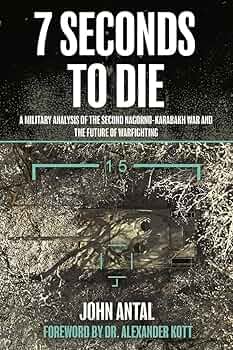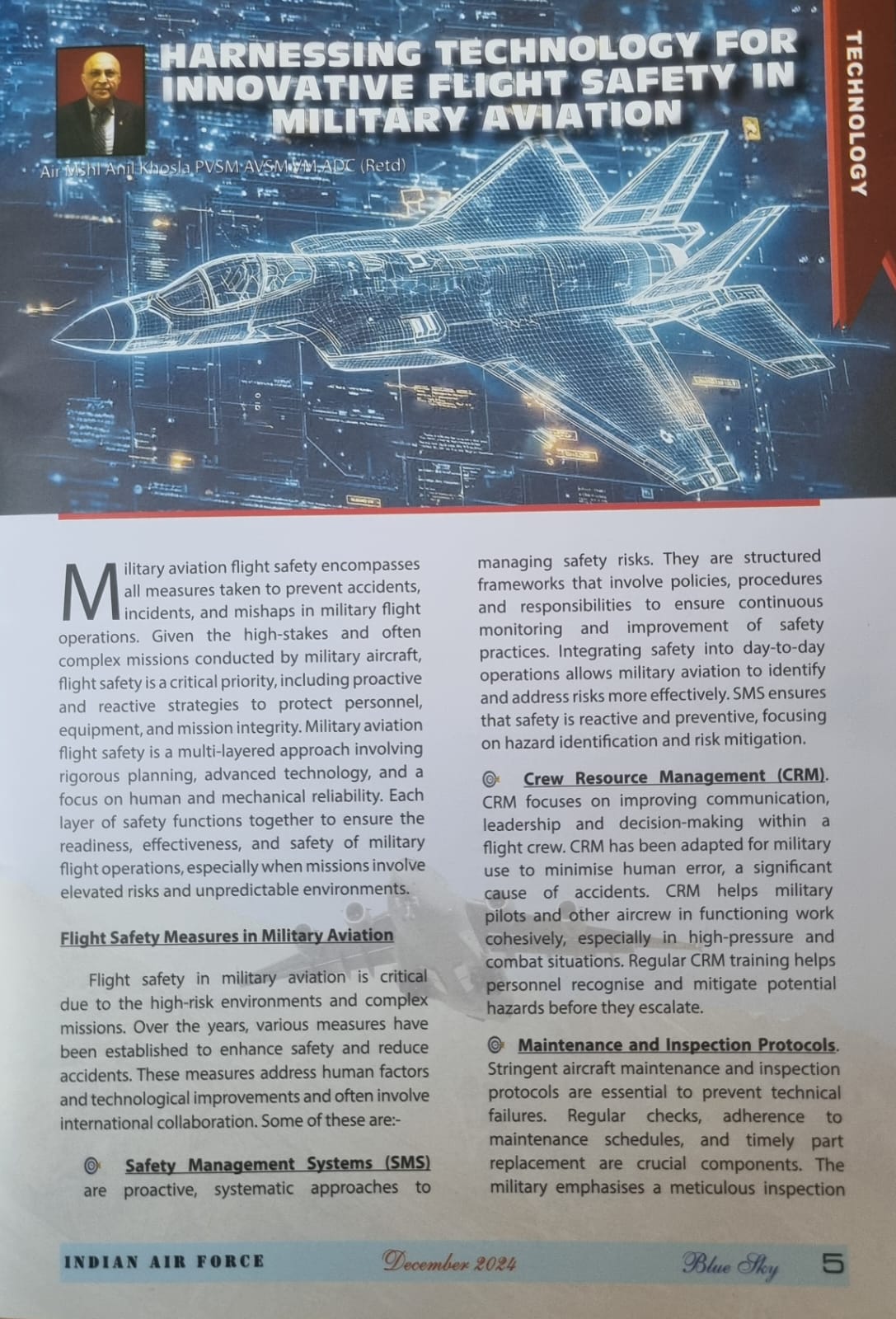
BOOK REVIEW: 7 SECONDS TO DIE
BY JOHN C. ANTAL
Review by: Air Marshal Anil Khosla (Retd) PVSM, AVSM, VM
Former Vice Chief of Air Staff, Indian Air Force.
John C. Antal’s 7 Seconds to Die offers a compelling and detailed analysis of the Second Nagorno-Karabakh War (2020), a conflict that showcased the decisive role of modern military technologies, particularly drones and artificial intelligence. This book transcends being a mere war chronicle; it is a profound exploration of how technological advancements reshape 21st-century military strategies. Antal’s approach, combining vivid storytelling with rigorous military analysis, makes this work indispensable for military professionals, strategists, and anyone interested in the future of warfare.
The Second Nagorno-Karabakh War erupted between Armenia and Azerbaijan over the disputed region of Nagorno-Karabakh. Though deeply rooted in historical and ethnic tensions, this war became a showcase for implementing cutting-edge technologies in combat. Azerbaijan, backed by Turkish military technology and Israeli-made drones, demonstrated a level of precision, speed, and lethality that overwhelmed Armenian forces. Antal contextualises the war within the broader framework of global military trends, emphasising that this was not just a regional conflict but a harbinger of future warfare. The title, 7 Seconds to Die, refers to the average time Armenian soldiers had to react once a drone detected their position. This chilling statistic underscores the deadly efficiency of unmanned systems.
Antal positions the Second Nagorno-Karabakh War as a critical case study in the ongoing Revolution in Military Affairs. He argues that integrating unmanned aerial vehicles (UAVs), loitering munitions, and advanced surveillance systems signifies a paradigm shift in combat operations. The book methodically details how Azerbaijan utilised these technologies to achieve information dominance, disrupt enemy supply lines, and conduct precision strikes with minimal human risk. Antal’s narrative is filled with examples of this technological edge. For instance, Azerbaijan’s use of Turkish Bayraktar TB2 drones and Israeli Harop loitering munitions not only neutralised Armenian air defences but also demoralised their troops. These systems enabled Azerbaijan to conduct a “kill chain”—identifying, targeting, and neutralising enemies—in seconds.
One of the book’s most striking insights is how technology levelled the playing field between two unevenly matched nations. Despite its superior terrain and entrenched positions, Armenia was unable to counter Azerbaijan’s technological superiority. Antal describes this as a shift from traditional measures of military strength—numbers, firepower, and fortifications—to a new era where speed, data, and adaptability are decisive. The author provides a nuanced analysis of the asymmetry created by drones. He explains that these technologies are not merely force multipliers; they are force disruptors. Traditional tactics, such as the use of trenches, tanks, and static artillery, became liabilities under constant drone surveillance.
Another profound theme in 7 Seconds to Die is the psychological toll of drone warfare. Antal vividly describes how Armenian soldiers, constantly under threat from an invisible and omnipresent enemy, experienced fear, confusion, and helplessness. This psychological dimension, he argues, is as significant as the physical destruction caused by drones. Antal also explores the implications of this psychological warfare for global militaries. The fear of being watched and targeted in real-time may fundamentally change the nature of combat, making it more about outwitting algorithms and less about confrontation.
Antal’s analysis extends beyond the Second Nagorno-Karabakh War to extract lessons for militaries worldwide. He emphasises the need for nations to adapt to this new reality, where traditional doctrines may no longer apply. His key recommendations include investing in counter-drone technologies, training soldiers to operate in environments dominated by UAVs, and developing doctrines prioritising speed, flexibility, and decentralisation. The book also raises critical ethical and strategic questions. How do nations balance using autonomous systems with the principles of humanitarian law? What happens when such technologies fall into the hands of non-state actors or rogue states? These are challenges that the global military community must address as the era of drone warfare matures.
Antal’s writing is both accessible and authoritative. He balances technical detail and engaging prose, making complex military concepts understandable to a broad audience. The book is well-structured, with each chapter building logically on the previous one. Antal’s use of maps, diagrams, and first-hand accounts enhances the reader’s understanding of the conflict’s dynamics. Moreover, the book’s pacing mirrors the rapid tempo of the war itself. Antal captures the urgency and unpredictability of modern combat, immersing the reader in the battlefield’s chaos while maintaining analytical clarity.
While 7 Seconds to Die is a ground-breaking analysis, it has shortcomings. The book is heavily focused on Azerbaijan’s success, sometimes at the expense of a more balanced view of Armenia’s strategies and failures. A deeper exploration of Armenia’s countermeasures (or lack thereof) would have provided a fuller picture of the conflict. Additionally, while the book excels in describing the tactical and operational implications of drone warfare, its treatment of the broader geopolitical consequences is relatively brief. For instance, how might the proliferation of such technologies affect regional stability in the South Caucasus? These questions deserve more attention.
Beyond its analysis of the Second Nagorno-Karabakh War, 7Seconds to Die is a wake-up call for nations and militaries worldwide. The book highlights the growing accessibility of advanced military technologies, raising concerns about democratising lethality. As Antal notes, the cost of entry for drone warfare is relatively low, meaning that even smaller nations or non-state actors can achieve disproportionate effects. The book also underscores the need for robust international norms and agreements to regulate the use of such technologies. Without clear rules, the risk of escalation, misuse, and collateral damage increases significantly.
7 Seconds to Die is a landmark work that captures the essence of 21st-century warfare. John C. Antal’s meticulous analysis of the Second Nagorno-Karabakh War offers valuable lessons for military professionals, policymakers, and scholars. The book is a sobering reminder that the future of warfare will be dominated by speed, precision, and technological ingenuity. While some gaps remain in its geopolitical analysis, Antal’s work is a testament to technology’s transformative power in shaping the battlefield. 7 Seconds to Die is an essential read for anyone seeking to understand the future of military conflict.
Your valuable comments are most welcome.
For regular updates, please register your email here:-
References and credits
To all the online sites and channels.
Disclaimer:
Information and data included in the blog are for educational & non-commercial purposes only and have been carefully adapted, excerpted, or edited from reliable and accurate sources. All copyrighted material belongs to respective owners and is provided only for wider dissemination.


